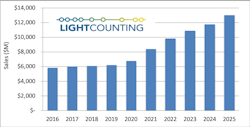Pandemic or not, optical transceiver sales will still grow in 2020: LightCounting
Life as a component and subsystem supplier is uncertain in the midst of the current COVID-19 coronavirus pandemic – as illustrated by the type of guidance (or lack of it) we’ve seen from recent corporate earnings statements (see, “Initial calendar 1Q20 optical component and transceiver revenue reports all over the map”). But LightCounting says there’s reason to be optimistic that the industry will be on more stable ground in the second half of the year, leading it to conclude, via its latest market forecast, that optical transceiver sales will still show year-on-year growth in 2020.
The market research firm notes that while transceiver production facilities in China opened early last month, most businesses in Malaysia and the Philippines remain closed and those in Europe and the U.S. are just starting to reopen. Nevertheless, LightCounting expects that overall transceiver production will reopen in the third quarter of this year and be fully humming by the fourth quarter. Given the demand for optical transceivers going into the year, that market will still have time to show revenue growth, LightCounting asserts. A leveling off of price declines will help achieve this outcome, the market analysts say in their report.
Modest revenue growth this year will accelerate to a 24% increase in 2021, LightCounting states (see chart above). Sales of optical modules for wireless fronthaul and backhaul applications will lead the way, showing 18% and 92% growth, respectively, thanks to 5G deployments in China. Such initiatives remain on target for 2020, according to the market researchers. Meanwhile, sales of FTTx optics and active optical cables will grow in the double digits this year, again thanks to China. And Ethernet and DWDM optical module sales will enjoy double-digit increases in 2021 as operators catch up after delays this year.
LightCounting’s April 2020 Market Forecast Report offers a market demand forecast through 2025 for optical components and modules used in Ethernet, Fibre Channel, CWDM/DWDM, wireless infrastructure, FTTx, and high-performance computing (HPC) applications. The forecast is based on LightCounting’s proprietary forecast model, which correlates transceiver sales with network traffic growth and the projected deployments of 5G and FTTx systems for broadband access.
For related articles, visit the Business Topic Center.
For more information on optical modules and suppliers, visit the Lightwave Buyer’s Guide.
To stay abreast of fiber network deployments, subscribe to Lightwave’s Service Providers and Datacom/Data Center newsletters.

Stephen Hardy | Editorial Director and Associate Publisher, Lightwave
Stephen Hardy is editorial director and associate publisher of Lightwave and Broadband Technology Report, part of the Lighting & Technology Group at Endeavor Business Media. Stephen is responsible for establishing and executing editorial strategy across the both brands’ websites, email newsletters, events, and other information products. He has covered the fiber-optics space for more than 20 years, and communications and technology for more than 35 years. During his tenure, Lightwave has received awards from Folio: and the American Society of Business Press Editors (ASBPE) for editorial excellence. Prior to joining Lightwave in 1997, Stephen worked for Telecommunications magazine and the Journal of Electronic Defense.
Stephen has moderated panels at numerous events, including the Optica Executive Forum, ECOC, and SCTE Cable-Tec Expo. He also is program director for the Lightwave Innovation Reviews and the Diamond Technology Reviews.
He has written numerous articles in all aspects of optical communications and fiber-optic networks, including fiber to the home (FTTH), PON, optical components, DWDM, fiber cables, packet optical transport, optical transceivers, lasers, fiber optic testing, and more.
You can connect with Stephen on LinkedIn as well as Twitter.
